Lion is regarded as the king of the jungle as it lies at the top of the food chain. It is a big, powerful, ferocious, and expert hunter. We have gathered a complete set of Lion Facts for Kids that will help kids in learning all about lions. You are going to learn about its scientific classification, size, weight, physical features, speed, strength, diet, habitat, population, life cycle, its cubs, different species, extinct lions, and many interesting facts about the lion.
Lion Facts For Kids
What is a Lion
- Lion is muscular, powerful and the second-largest cat after Tiger in the world.
- It inhabits savannas and grasslands and usually lives in groups called pride.
- It is an alpha predator (also called top predator), which means it has no predators naturally to hunt it down and exists at the top position of the food chain.
- It is also a keystone predator, which means it has a larger influence on its environment than its abundance. It plays a key role in maintaining the population of other animals in an ecological community.
- Lion is called “king of the jungle” and is one of the animals that are most extensively portrayed in national flags, paintings, and sculptures.
- In human traditions, the lion is one of the most recognized animal symbols.
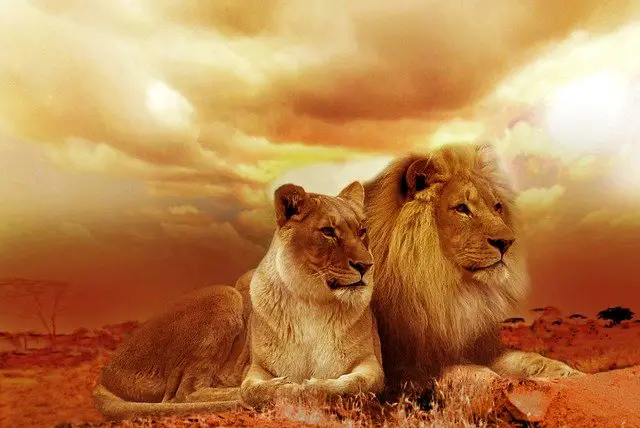
Scientific Name of Lion
- Panthera leo is the scientific name of the lion.
What Species is a Lion
- Lion belongs to the Felidae family, which is a pedigree of meat-eating animals commonly known as cats.
- Animals of this family are called felids or felines, characterized by muscular and slender bodies, retractable claws and powerful flexible forelimbs, specially transformed cranium and dental system for a vigorous bite, and specific coat patterns for a disguise that often have spots or strips.
- Members of this family are carnivores, which means they survive on the nutrients found only in the flesh of animals.
- Sometimes, members of this family are also called Hyper-carnivores because meat makes more than 70% part of their diet.
- Out of all 13 families in the order Carnivora, members of the Felidae family are the strictest carnivores.
What do Lions Look Like
- A lion has a small round head, a small neck, disk-shaped ears, and a tail with hair on its tip.
- It has a strong and muscular body, a deep chest, and a coat color ranging from golden-yellow to yellowish-brown.
- Male lions have a prominent shaggy mane, color, and length which varies with age and are also influenced by hormones and genetics.
- Lions of young age have light spots on their coats that disappear as they grow.
- Lions have sexual dimorphism; the females (lionesses) typically have a different appearance and a smaller size than males, a special characteristic that is a lack in other cat species.
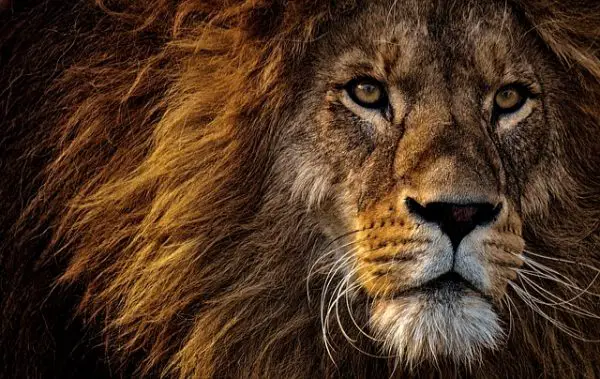
Lion Characteristics – Special Features of Lion
- The lion is a powerful cat with a muscular body and strong flexible legs.
- Male and female lions have different body weights, sizes, and appearances.
- The average weight of an adult male lion is about 181 kg (399 pounds).
- An outstanding characteristic of the male lions is their mane.
- The color and length of a lion’s mane not only reveal his age but also his behavior.
- Lions live in groups called “pride”. A pride has 1 to 4 male lions, several females, and their offspring.
- Each pride has its territory that may cover up to 100 square miles.
- A female gives birth to 1 to 6 cubs after a gestation period of about 110 days.
- The Lion cubs mature at the age of 2 years.
- Lions are hyper-carnivores – animal flesh makes more than 70% part of their diet.
- An adult male lion requires an average amount of 7 kg of meat per day to survive.
- Lions usually live for 10 to 14 years in the wild, and 20 to 25 years in captivity.
How Big is a Lion – Lion Size
- The body length of an adult lion ranges from:
- Male Lion – 5 feet 7 inches to 9 feet 9 inches (170 to 298 cm).
- Female Lioness – 4 feet 7 inches to 5 feet 9 inches (140 to 175 cm).
- The tail length of an adult lion ranges from:
- Male Lion – 2 feet 11 inches to 3 feet 5 inches (90 to 105 cm).
- Female Lioness – 2 feet 4 inches to 3 feet 3 inches (70 to 100 cm).
How Big do Lions get
- Lions usually grow bigger in captivity than in the wild.
- Male lions grow slightly bigger than females with 170 to 298 cm of body length and a weight of 150 to 250 kg.
- Females attain a body length of 140 to 175 cm and a weight of 120 to 182 kg.
- The biggest lion ever recorded was about 11.8 feet long with a weight of 408 kg.
- Hercules Liger (offspring of a male lion and a female tiger) is 332 cm long, 124 cm (49 inches) high, weighs 418 kg (922 lb) and is the world’s biggest living cat mentioned in the 2014 Guinness Book of World Records.

How Much Does A Lion Weigh – Lion Weight
- The average lion weighs from:
- Male Lion Weight – 330 to 550 pounds (150-250 kg)
- Female Lion Weight- 265 to 401 pounds (120-182 kg)
- The South African lion weighs from:
- Male Lion Weight – 413-426 pounds (187-193 kg)
- Female Lion Weight- 274-308 pounds (124-139 kg)
- The East African lion weighs from:
- Male Lion Weight- 386 pounds (175 kg)
- Female Lion Weight – 163 pounds (119 kg)
- The Indian lion weighs from:
- Male Lion Weight- 350-420 pounds (160-190 kg)
- Female Lion Weight- 240-260 pounds (110-120 kg)
How Long is a Lion
- The body length of male lions without tails ranges between 1.7 to 2.98 meters (5 feet 7 inches to 9 feet 9 inches).
- Female lions have body lengths between 1.4 to 1.75 meters (4 feet 7 inches to 5 feet 9 inches).
- The tail length of an adult lion ranges from:
- Male Lion – 2 feet 11 inches to 3 feet 5 inches (90 to 105 cm).
- Female Lioness – 2 feet 4 inches to 3 feet 3 inches (70 to 100 cm).
How Fast is a Lion – How Fast Does a Lion Run
- The estimated maximum and fastest speed of a lion in short bursts is 80 km/hr or 50 miles/hour.
How Long Can a Lion Run
- Lions can run at the speed of 80 km/h or 50 mph for short distances.
- They can jump up to about 36 feet while running faster.
- Due to the lack of stamina, lions can not keep running at top speed for long distances.
How Long Do Lions Live – Lions Lifespan
- The lifespan of lions depends on whether they live in the wild or captivity.
- They usually live longer in captivity than in the wild due to the regular availability of food, proper health care, and protection from natural threats and diseases.
How Long Do Lions Live in the Wilds
- In the wild, the usual lifespan of lions is 10 to 14 years.
- The maximum lifespan of lions recorded in the wild is up to 18 years, however, very few of them reach this age.
How Long Do Lions Live in Captivity
- In captivity, Lions live for more than 20 years.
Lion Life Expectancy
- The life expectancy of lions in the wild is 10 to 14 years.
- In captivity, they live for 20 to 25 years.
What do Lions Eat – Lions Diet – Lion Diet Facts
- Lions are strictly carnivores in nature and consume meat or flesh of other animals as food.
- An adult male lion needs about 15 pounds (7 kg) of meat per day, while the amount needed for a female lion is about 11 pounds (5 kg).
- An adult male lion can eat up to 66 pounds (30 kg) of meat at a time.
What Animals Do Lions Eat – Lions Prey
- Lions prey upon zebras, antelopes, giraffes, other large ungulates (hoofed mammals), and crocodiles.
- They also hunt young elephants, rhinoceros, and hippopotamus, and ignore the fully grown ones.
- Sometimes, they also eat mice, turtles, lizards, birds, and hares.
What do African Lions Eat – African Lion Diet
- African lions like to hunt animals of weight between 240-1,210 pounds (190-550 kg).
- They prefer to hunt animals like plain zebra, giraffe, blue wildebeest, gemsbok, and African buffalo.
- They usually avoid very small animals like vervet monkey, dik-dik, hare, and also avoid very large animals like completely developed adult hippopotamus, rhinoceroses, and elephants.
- The African lions also like to prey on some animals species below the range of the preferred weight if available in abundance, such as common warthog and Thomson’s gazelle.
- In many regions, very few animal species make up to 75% part of lions’ diet.
- For example, giraffes and Cape buffalo are the most common animals consumed by lions in Kruger National Park and Manyara Park, respectively.
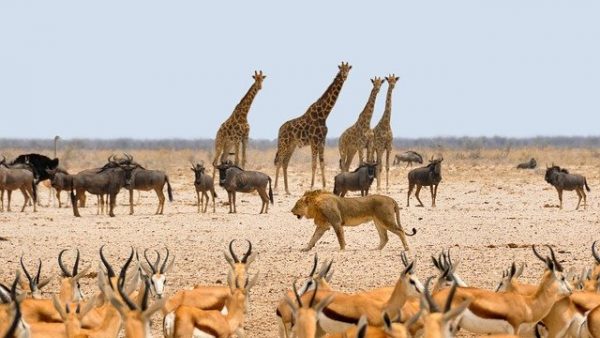
What do Lions Like To Eat
- Lions are carnivores and like to eat the flesh of other animals.
Where Do Lions Eat
- Lions usually eat their prey at the place of killing, however, sometimes they pull their larger kills into a covered place.
- If they are unable to eat all their prey at one time, they wait for a few hours and then continue eating.
- In hot seasons, the whole pride often goes back to shadow after hunting and leaves one or two male lions to guard the kill.
- Lions always defend their dead prey from scavengers like hyenas and vultures.
Read this to know more about: What do lions eat
How Do Lions Prey and Eat
- Due to the lack of stamina, lions use short distances to attack their prey.
- They attack very powerfully and try to catch the prey with a quick and final jump.
- They usually strangulate and kill the prey by causing asphyxia (a condition of blocking oxygen supply to the body) or cerebral ischemia (a condition of insufficient blood supply to the brain).
- Lions typically hunt at night and a single lion alone can bring down a prey double its size.
- Young lions do not take part in hunting and only show stalking behavior for the first three months of their lives.
- After the age of one year, they start hunting and at the age of two, they become trained and effective hunters.
- Female lions (lionesses) hunt cooperatively and do most of the hunting in pride. Male lions like to hunt alone and usually do not take part in group hunting.
- All the members of the pride are fed well by the large kills, however, cubs are mostly suffering in cases of scarce food.
Lion Teeth Facts
- Like other members of the family Felidae, lions have dental formula 3.1.3.1 / 3.1.2.1 and have a total of 30 teeth.
- They have canine teeth of exceptional size, which they use for a strong bite and killing the prey.
- Their lower molar and upper third premolar teeth are called Carnassial teeth, specially adapted for cutting and tearing and work like two scissors.
- Their upper Carnassial is larger than lower Carnassial and has a dental cap with two squeezed blade-like pointed ends or cusps.
- Lions do not chew food and swallow it directly after chopping.

Where Do Lions Live – Where Lion Lives – Lion Habitat
- Lions prefer to live in savannas, open woodlands, scrubs, and grasslands.
- The home area of a lion pride range from 13 to 100 square miles.
- They are absent in rainforests and other dense forests, maybe due to the presence of other big cats in such habitats as leopards and tigers.
Where Are Lions Located – What Countries Do Lions Live In
- Lions were found all around Africa, Eurasia, and the Americas in the Pleistocene epoch (Ice Age).
- Nowadays, their populations are very small and restricted to only a few specific regions in the world.
- They are found in the countries of Sub-saharan Africa, where their populations are fragmented.
- The countries where they are found are the Eastern African Countries like Tanzania and Kenya, and the Southern African Countries such as Zimbabwe, South Africa, Zambia, and Botswana.
- In India, only one population of lions is found which is listed as critically endangered.
African Lion Habitat
- In Africa, the well-known habitats of lions are:
- Serengeti National Park in the eastern African country; Tanzania
- Etosha National Park in the south-western African country; Namibia
- Kruger National Park of South Africa
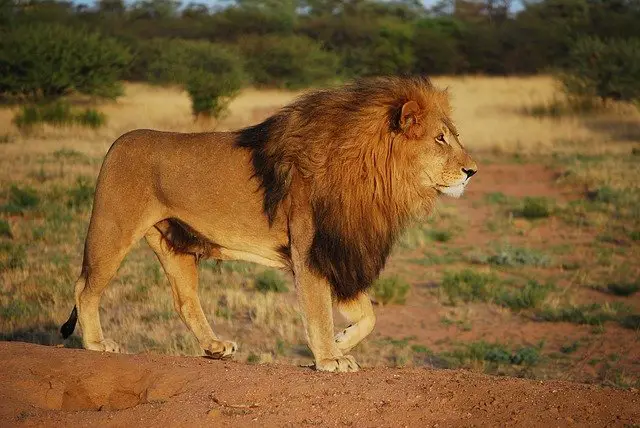
Habitat Of Lion in India
- Gir Forest National Park and the surrounding areas in Gujarat state are the only habitats of lions in India as well as in entire Asia.
Lion Habitat Map
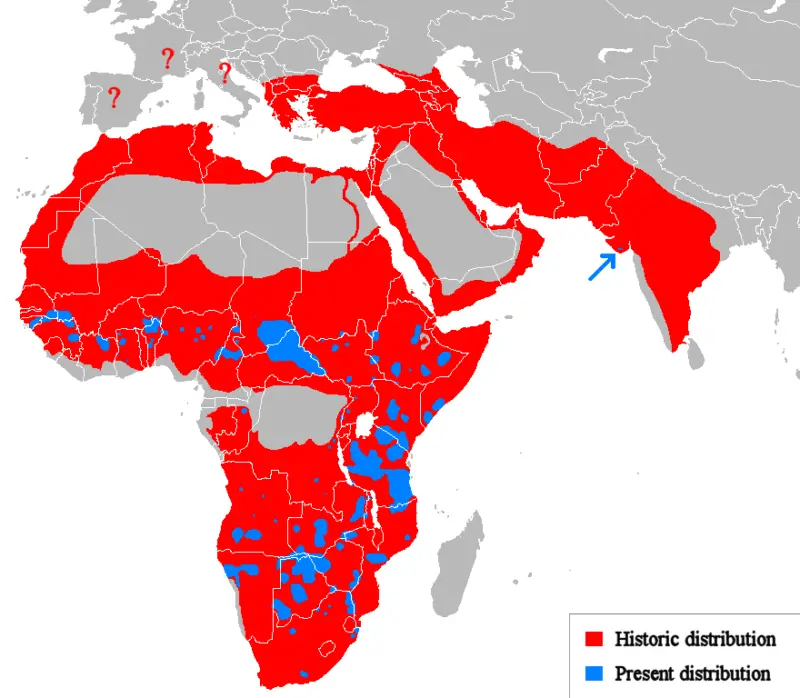
Male and Female Lion
- Lion is the only cat species that possess sexual dimorphism.
- Male lions have a prominent mane around their neck and head. The color and length of the mane not only indicate the age of a male lion, but also its skills and bravery.
- Female lions do not have a mane and are usually smaller in size and weight the male lions.
What Is Female Lion Called
- A female lion is called a Lioness.
What Is A Male Lion Called
- A male lion is simply called a Lion.
Female Lions Hunt
- Female lions are typically responsible for hunting in pride.
- However, male lions usually participate when their help is needed, such as in the case of bringing down a large-sized prey like the giraffe and Cape buffalo,
- Female lions hunt in groups mostly in the early morning and evening.
What Do Male Lions Do
- Male lions are solo hunters and do not hunt in groups.
- In pride, security is the primary responsibility of male lions.
- They guard their territory and keep out other pride and predators that might affect the food supply of their pride.
- Male lions always patrol especially to ensure that their territories are clear of other predators.
- Male lions do not let their territory be occupied by other pride even if they lose their lives in the fight.
Baby Lion Facts
- Baby lions are called cubs.
- They are born blind like the puppies and kittens and can not open their eyes till the eighth day of their birth.
- They are introduced to their pride at the age of 6 to 8 weeks.
- As lions are mammals, the females nurse their cubs for about 6 to 7 months.
- Cubs depend on mothers for the initial 3 months of their lives, and after 3 months they start eating meat.
- Male lions become mature at the age of about 3 years.
- Before the age of two, about 80% of cubs die due to several reasons including;
- When an outsider lion usurps a pride, he kills all the male lions and cubs.
- Predation by hyenas, leopards, and wild dogs.
- Starvation.

What is a baby lion called?
- A baby lion is called a Cub.
What does a baby lion look like
- A baby lion has yellowish-red fur with spots that disappear with age.
- A cub looks like a domestic cat.
The life cycle of a lion – Lion Reproduction
- Male lions mature at the age of 3, while lionesses mostly mature and can reproduce at the age of 4.
- Male and female lions mate throughout the year as lionesses are polyestrous.
- The gestation period lasts for about 110 days.
- The lionesses give birth to a litter of one to four cubs in a hidden den typically away from the pride.
- At birth, the cubs weigh about 2.6 to 4.6 pounds (1.2 to 2.1 kg).
- They are nursed by mothers for 6 to 7 months.
- The females within a pride often reproduce synchronously and nurse the cubs of each other without any discrimination.
- Cubs stay with mothers till the age of 2 years.
- The females do not mate until their cubs reach the age of 2 years.
- After the age of 2, female offsprings usually remain with their birth pride while the males are often driven out by the heads of the pride.
- Lions become weak and age between the age of 10 to 15.
- The maximum lifespan of a lion in the wild is up to 16 years.
How Many Cubs Do Lions Have
- A female lion usually gives birth to a litter of 1 to 4 cubs at a time.
Lions In USA
- An extinct subspecies of the lion called the American lion or North American cave lion (Panthera leo atrox) lived in North America during the Ice Age (Pleistocene epoch).
- Their fossils revealed that they were about 25% bigger than the present-day African lions.
- Most of their fossils have been discovered from the La Brea Tar Pit in urban Los Angeles.
- The Cougar, which is also known as the Panther, Puma, Catamount, or Mountain lion, is sometimes also known as the American lion.
- However, the Cougar is a different species than the lion.
What Is A Group Of Lions Called
- Lions usually live in groups called “Pride”.
- The average number of individuals in pride is 15 including about 4 adult males, several females, and their offspring.
- The largest observed pride was made up of 30 lions.
How Many Male Lions Are In A Pride
- The maximum number of male lions in pride is 4.
- However, prides usually have 3 adult male lions.
How Do Lions Pride Work
- Male and female lions in pride have specific responsibilities.
- Male lions mostly secure their territory and pride from any outsider lions.
- They patrol regularly to protect their pride from being usurped by outsider lions.
- Lionesses provide food for the pride by hunting, however, males also participate when they are needed.
- Females also take care of the cubs.
Lions Behaviour
- Lions are social wild cats that live in special groups called “pride”.
- Although, some lions of both sexes become nomads and prefer to live alone.
- Each pride has its territory of about 100 square miles.
- The male lions of pride have the statuses of kings within the pride. They defend their pride and territories even at the cost of their lives.
- When male cubs mature, the adult male lions chase them away from their birth prides.
- However, most of the female cubs prefer to remain with their maternal pride.
- The female lions secure their cubs and after birth, she regularly moves them to a new hidden site many times in one month to avoid the buildup of scent that may attract any predators.
- Lionesses have a special fixed social unit within pride and do not tolerate the presence of any outsider females.
- The females also do most of the hunting of the pride. The male lions are fed first, then females, and in last the aged lions and cubs.
- When a male lion usurps a pride, he kills all the pride’s members except the females.
How Do Lions Protect Themselves – How Do Lions Survive
- Lions live in pride, where they are more secure and also have equal chances of survival.
- In case of any danger, they roar to communicate with the other members of the pride.
How Lions Move
- Lions usually spend about 20 hours of the day in rest.
- The average time of their movement is only 2 hours per day.
- When they move, the cubs usually move with their mothers.
Lion Species – Types Of Lions
- There are only one species of the lion in the genus Panthera that is the Panthera leo.
- From 2008 to 2016, the assessors of the IUCN Red List utilized only two subspecies of lion. That is;
- The African lion (Panthera leo leo)
- The Asiatic lions (Panthera leo melanochaita).
- However, the Cat Specialist Group selected members from the group as the Cat Classification Task Force in 2017, who revised the lion’s subspecies classification as:
- The Panthera leo leo, which includes;
- The Asiatic lion (Panthera leo persica)
- The West African lion (Panthera leo senegalensis)
- The Northeast Congo lion (Panthera leo azandica)
- The Katanga or Southwest African lion (Panthera leo bleyenberghi)
- The Panthera leo melanochaita includes;
- The Cap lion (Panthera leo capensis)
- The Masai lion (Panthera leo massaica)
- The Transvaal lion (Panthera leo krugeri)
- The Panthera leo leo, which includes;
African Lion – African Lions Names
- Out of all the subspecies of lions, only the Panthera leo persica is found in Asia (India).
- All the other subspecies are found in Africa due to which they are called the African lions. Their names are;
| S.No | Common Name | Scientific Name |
| 1 | The Cap lion | Panthera leo capensis |
| 2 | The Northeast Congo lion | Panthera leo azandica |
| 3 | The Transvaal lion | Panthera leo krugeri |
| 4 | The Masai lion | Panthera leo massaica |
| 5 | The West African lion | Panthera leo senegalensis |
| 6 | The Katanga or Southwest African lion | Panthera leo bleyenberghi |
South African Lions
- The South African lion is a subspecies that belongs to panthera leo melanochaita.
- It is found in Southern countries of continent Africa, like South Africa, Angola, the Democratic Republic of the Congo, Namibia, Zimbabwe, Mozambique, Zambia, Botswana, Swaziland, and Malawi.
- South African lions have a black mane and are considered the largest of all the living subspecies of African lions.
West African Lions
- The West African lion belongs to Panthera leo leo and is found in western Africa.
- Its population is critically endangered.
- Before 2017, the West African lion has considered a separate lion subspecies with the name Panthera leo senegalensis.
- However, in 2017 all the lion populations in Central, North and West Africa, and Asia were included in Panthera leo leo.
East African Lions
- The East African lion belongs to Panthera leo melanochaita and is found in East African countries.
- They are well-known for a wide variety of mane.
Asiatic Lions Facts
- Asiatic lion belongs to Panthera leo leo.
- They are listed on the IUCN Red List as Endangered.
- Nowadays, they are only found in the Gujarat state of India, where they are confined to the Gir Forest National Park and its surrounding areas.
- The existing population of Asiatic lions in the wild is estimated as about 650 individuals.
- Generally, Asiatic lions have a less developed mane than African lions.
Extinct Lions
- The lion’s subspecies that existed during the prehistoric era which are extinct now, include the following:
- Panthera leo fossilis – Fragments of their bones have been discovered in Italy, Germany, Czech Republic, and the United Kingdom. They existed between 680,000 and 600,000 years ago.
- Panthera spelaea – Existed about 14,900 to 11,900 years ago. Their bone fragments have been discovered in North Asia, Europe, Alaska, and Canada.
- Panthera leo atrox or Panthera atrox – Existed about 10,000 years ago in the Pleistocene epoch (Ice Age) in the Americas.
White Lions Facts
- White lions have white coat color due to a less severe mutation of a gene that causes albinism in case of severe mutation.
- However, white lions are not albinos.
- Genetically, they are like the Southern African lions (Panthera leo melanochaita).
- According to the Global White Lion Protection Trust (GWLPT), they are completely normal lions and their coloration does not cause any problem to their survival.
- In the wild, white lions are found in South Africa mainly in the Timbavati region where they have special cultural importance to the native communities.
- In captivity, there are about 300 white lions present in the zoos of Eurasia, the Americas, and New Zealand.
Black Lions Facts
- Black lions do not exist.
- The black lion in a famous picture that went viral is the color palette manipulation of a picture of a white lion.
- That picture of the white lion was taken at the Cango Wildlife Ranch in Oudtshoorn (South Africa).
Are Lions Endangered
- Asiatic lions are on the IUCN Red List as “Endangered” since 2008.
- The African lions are also on the IUCN Red List as “Vulnerable” (decreasing population).
Why Are Lions Endangered
- Lions are endangered due to several reasons, including:
- Poaching – the illegal hunting of lions for their bones, which are used in traditional medicines as well as inexpensive wines.
- Killing by humans for Trophy Hunting and Big-game Hunting
- Loss of habitat
- Conflict with humans
- Food and prey scarcity
- Natural threats and diseases
Lions Population
- In 2002-2004, the population range of African lions in the wild was estimated between 16,500 to 47,000.
- The population of Asiatic lions was estimated to be 650 by the Asiatic Lion Census in 2017.
What are lion’s predators?
- Lions do not have natural predators, as they are themselves, alpha predators.
- However, human beings are the only predators of lions.
Do Lions Live In The Jungle
- No, lions do not live in the jungles and dense forests.
Do Lions Live In The Forest
- No, generally lions don’t live in forests.
- However, there exists a small population of Asiatic lions in the Gir Forest National Park.
Interesting Facts About Lions
- Lions are the most social of all cats and live in groups called pride.
- The roar of an adult male lion can be heard up to 8 km away from its source.
- The heels of a lion do not touch the ground during walking.
- The mane color of a lion is a good measure of its age. Old lions have darker manes.
- Lions have five times better eyesight than humans.
- Lions can’t climb trees, unlike leopards who make it look so easy.
- The mane and canine teeth of a male lion fall off when he gets old.
- A lion is sometimes called the “King of the Jungle”, while it does not live in jungles or dense forests.
- The heart of a male lion comprises only about 0.45% of his body weight, due to which it lacks stamina and can run at its top speed only for short distances.
- A lion rests for about 20 hours a day.



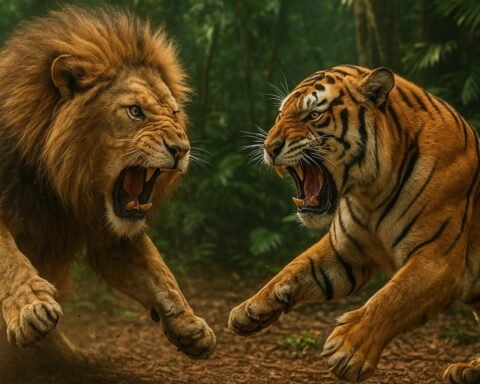








pls have more facts about lions